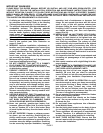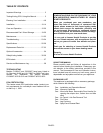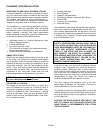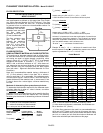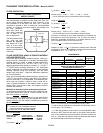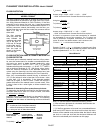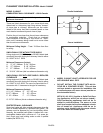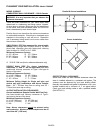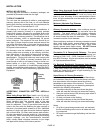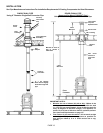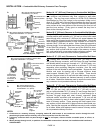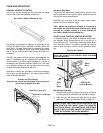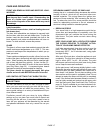
INSTALLATION
PAGE 10
INSTALLING LEG PADS
The four leg pads (included in accessory package), are
provided for placement under the four legs.
TYPES OF CHIMNEYS
The unit must be connected to either a code-approved
masonry chimney with a flue liner, or a 6 inch diameter
factory-built chimney complying with the requirements for
Type HT chimneys in the standard UL 103.
The chimney is a vital part of your stove installation. A
properly built masonry chimney or a properly installed
factory-built chimney will assure a consistent draft under
a variety of weather conditions (a smoking stove is usu-
ally caused by a chimney problem). The stove flue size is
6 inches diameter, which is approximately 28 square
inches minimum. The maximum flue size should be no
more than (3)-three times the cross sectional area of the
size of the stove flue collar. In this case, that would be no
larger than an 10-inch diameter stack, or approximately
85 square inches maximum.
All chimneys must be installed as specified by local
building codes and according to the chimney manufac-
turer instructions (in the case of a factory-built chimney).
See the chimney manufacturer instructions for exact
specifications. Factory-built chimneys must comply with
UL 103HT or ULC S629. A chimney connector shall not
pass through an attic or roof space, closet or similar con-
cealed space, or a floor, or ceiling. Where passage
through a wall, or partition of combustible construction is
desired, the installation shall conform to CAN/CSA-B365,
Installation Code for Solid-Fuel-Burning Appliances and
Equipment.
ACCEPTABLE CONNECTOR PIPE FOR INSTALLA-
TIONS
When Using Single Wall Pipe:
Install a six (6) inch di-
ameter, single wall, 24 MSG black steel or 26 MSG
blued steel connector pipe on the flue collar of the unit.
When installing pipe, the crimped ends of the pipe
should all point down. Position all seams toward the
back for aesthetics. Three (3) pre-drilled holes are pro-
vided in the flue collar for fastening the pipe securely to
the stove. Use sheet metal screws to do this. Additional
sections of single wall pipe should be fastened together
with at least three (3) sheet metal screws each section.
All pipe connections must be sealed (ie. high tempera-
ture silicone). When connecting to the factory-built ceiling
support package, use the manufacturer's transition
piece, usually called a dripless connector, to join single
wall pipe to their factory-built chimney section.
When Using Approved Double Wall Pipe (Approved
for Model CI2000HT Only): Type L and listed double
wall connector pipe is acceptable. Install any factory-built
brand of pipe according to the manufacturer's instruc-
tions. All pipe connections must be sealed (ie. high tem-
perature silicone).
Minimum / Maximim Flue Diameter
:
Minimum 6", Maximum 10"
Chimney Connector Adapter
- Use a chimney connec-
tor adapter to connect the chimney connector up to the
chimney. The small ends of the chimney connector
should all point down for a drip free installation. Position
all seams toward the back for aesthetics. The chimney
connector must be 6-inch diameter.
Secure adjoining sections of chimney connector to each
other using three equally spaced sheet metal screws.
Secure the connector pipe to flue collar using three
equally spaced sheet metal screws. DO NOT secure
chimney connector to chimney with screws.
Connection To A Factory-built Chimney
- This space
heater is to be connected to a factory-built chimney con-
forming to CAN / ULC – S629, Standard for 650°C Fac-
tory-Built Chimneys. All pipe connections must be sealed
(ie. high temperature silicone).
For Reduced Residential Clearances Using Double
Wall Pipe (Approved for Model CI2000HT Only): Type
L and listed double wall connector pipe is acceptable.
Install any factory-built brand of pipe according to the
manufacturer's instructions.
Vapor Barrier at Chimney Penetration
Install all venting components per the Vent Manufactur-
ers installation instructions. Ensure that there is an effec-
tive vapor barrier at the location where the chimney
penetrates to the exterior of the structure. This can be
accomplished by applying a non-hardening waterproof
sealant to the following components:
• Around the chimney at the point where the storm
collar will meet the chimney just above the Flashing.
• Along the vertical seam of the chimney pipe, where it
is exposed to the weather.
• On each nail head on the flashing.
• Around the chimney at the point where the storm
collar will meet the chimney just above the flashing.
Notes:
• On a flat or tarred and graveled roofs, nail and seal
the flat roof flashing to the roof on all sides with roof-
ing compound.
• Do not put screws through the flashing into the chim-
ney pipe.
Tile-lined
Masonry
Chimney
Factory
Built
Chimney



